

Jean-Micheal Basquiat was an American artist during the 70’s and 80’s before his death in 1988. He was part of the Neo-expressionists movement which was a style of late-modernist and postmodern painting as well as sculpture that arrived in the 70’s.

The Neo-expressionists were called the Neue Wilden or ‘New Fauves’ for their continuation of abstract expressionism, “intense subjectivity” and aggressive use of materials. This style came as a reaction against the minimal and conceptual art of the late 60’s and early 70’s, and is characterized by violent emotion, saturated colours, and (often abstract) recognizable figures. Though Basquiat’s life was ended at a young age, the influence that he made during those 28 years is still taking effect today.
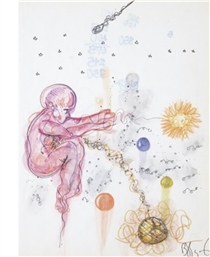
Basquiat was born in Brooklyn, New York in 1960 to a Haitian father and mother of Peurto Rican descent. In his early life, Basquiat’s mother, Matilde, introduced a love for art to her son by bringing him to Manhattan museums and making him a junior member of the Brooklyn Museum of Art. Basquiat was a deeply gifted child as he learning how to read and write by age 4 in addition to being a very talented artist. After his mother and teachers began noticing his abilities he was quickly sent to develop this skill at Saint Ann’s School, a private school with a focus on the arts. At this school, he met a childhood friend, Marc Prozzo, who would illustrate a novel that Basquiat had written – together they created their first book at age seven.
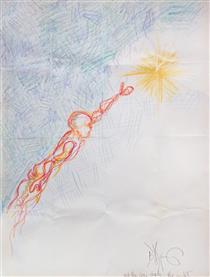
At the age of 17, after changing from E. R. Murrow High School to the alternative high school City-As-School, Basquiat was expelled for pieing the principle – an awesome way to go out if you ask me; rebellious and counter-cultural from the start. After this, his parents kicked him out of the house and he began spray painting graffiti throughout Lower Manhattan with his schoolmate Al Diaz, under the pseudonym SAMO (same old shit). After leaving school, Basquiat joined Harry Styles in the “Don’t Have More Than A Tenth Grade Math Level” Hall of Fame. He began making postcards and t-shirts with inscribed messages and designs about SAMO as a way to make an income before getting hired to work for the Unique Clothing Warehouse in NoHo. On December 11, 1978, Basquiat had his first big break when The Village Voice published an article discussing SAMO graffiti.
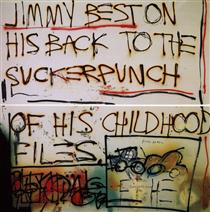
The ball kept rolling and in 1979 Basquiat appeared on the television show TV Party with the host Glenn O’Brien and the two formed a long-lasting friendship. Over the next several years Basquiat was regularly shown on TV Party and on one occasion he met Micheal Holman and together they formed a noise rock band called Gray (a notable member of the said band was Vincent Gallo). Graffiti, art, clubs, no pre-calculus 12, and bands?? Jean-Micheal was experiencing every drop of New York Culture and living the dream of every teenage artist.

At this time, Basquiat was living with his friend Alexis Alder in the East Village. Alder was a biology graduate and allowed Basquiat to borrow her diagrams and models from her textbooks in his pieces while she documented his creative process and explorations (he transformed the floors, walls, doors, and furniture of their apartment into works of art. He still continued to make his postcards and collaborated with his friend Jennifer Stein and on one instance even sold Andy Warhol a postcard titled Stupid Games, Bad Ideas.
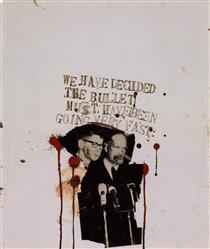
In 1980, at the same time as Al Diaz and Basquiat ended their friendship (and thus ended SAMO with the dramatic epitaph “SAMO IS DEAD” on a SoHo building), Basquiat started filming for Glenn O’Brien’s film Downtown 81 where Gray would feature on the soundtrack. 1980 was a turning point for the young artist as now he would be known as a solo artist. He first participated in The Times Square Show – a multi-artist exhibition before going onto dominate the art world by appearing in the MoMA, and many international solo shows. In this period Basquiat was interested in painting objects that he found in the streets such as helmets, furniture and discarded doors.
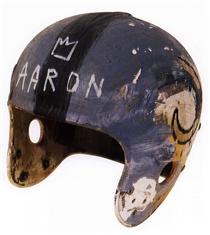
In 1986, Basquiat, accompanied by his girlfriend Jennifer Goode, traveled to the Ivory Coast for an art exhibit where Goode tried and failed to get Basquiat to attend a methadone program. The following year was hard for Basquiat who walked the runway for Rei Kawakubo at the Comme Des Garcons show in Paris while struggling with his substance abuse and mental health. After the death of Andy Warhol in 1987, Jean-Micheal Basquiat fell out of his artistic groove and further into his drug use.
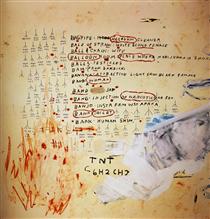
Friends attempted to bring Basquiat out of his rut and even after an extended trip to Maui he seemed to have kicked his drug dependency but even so, Basquiat died of a heroin overdose in Manhattan studio on August 12, 1988. In memory of the late artist, Keith Haring created the painting A Pile of Crowns for Jean-Michel Basquiat. In the obituary he wrote for Vogue, Haring stated: “He truly created a lifetime of works in ten years. Greedily, we wonder what else he might have created, what masterpieces we have been cheated out of by his death, but the fact is that he has created enough work to intrigue generations to come. Only now will people begin to understand the magnitude of his contribution”.


December 18, 2020 at 1:24 am
Hey, I’ve been having some issues uploading/viewing the blog so let me know if you can see this!